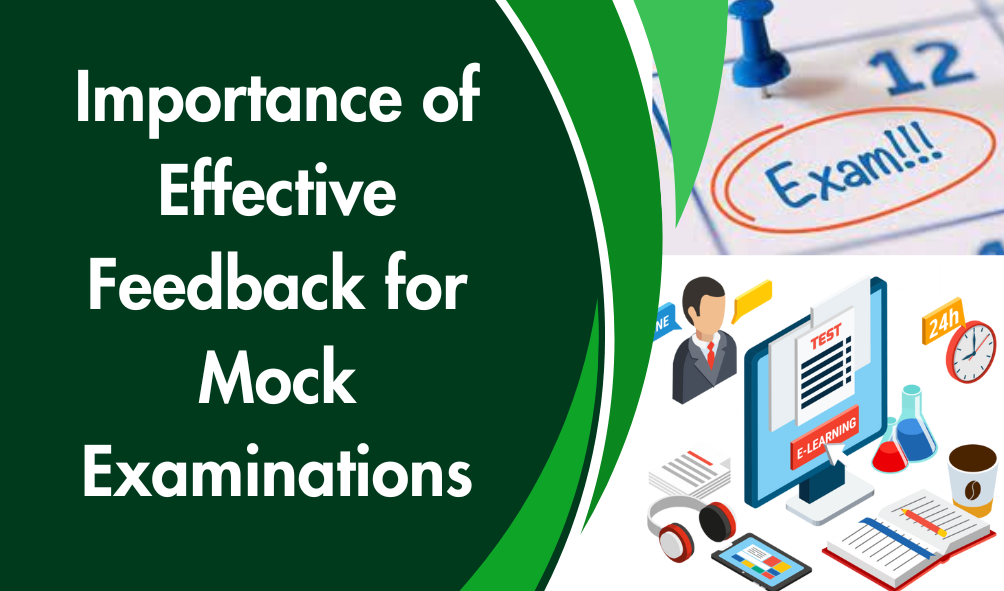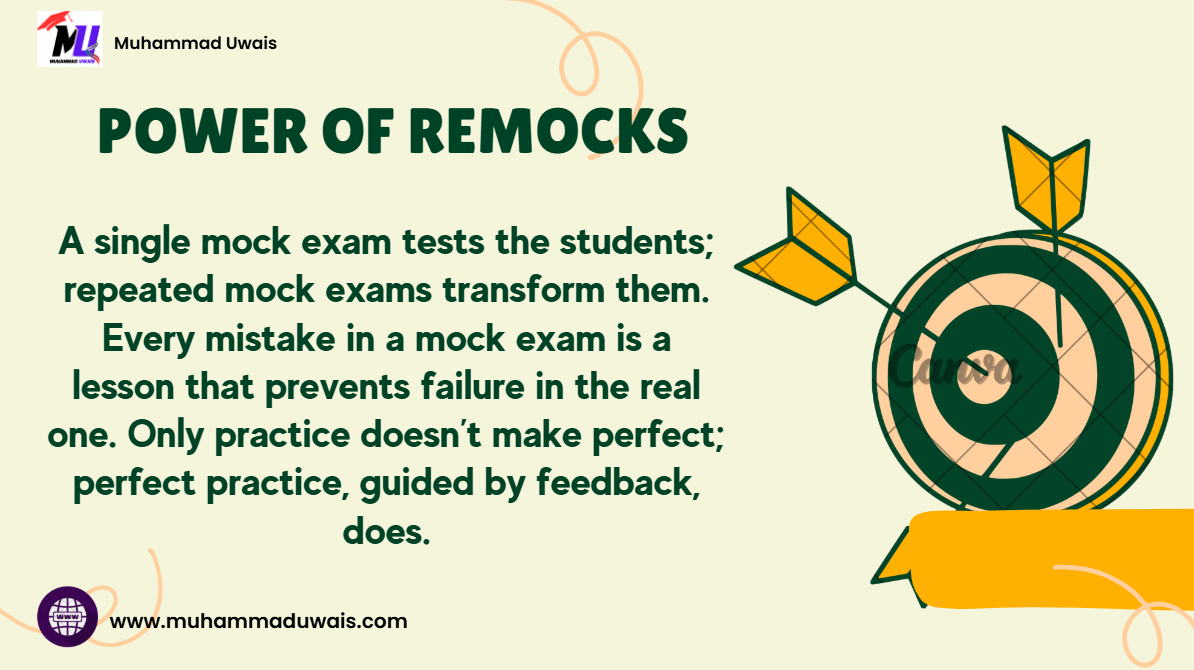Mock examinations are an integral part of the learning process, especially for students preparing for high-stakes exams such as Cambridge A Levels or other standardized tests. While mock exams simulate the real examination experience, their true value lies in the feedback that follows. Effective feedback from these exams can significantly enhance a student’s learning journey by identifying strengths, exposing weaknesses, and fostering growth.
1. Identifying Knowledge Gaps
Effective feedback highlights the areas where students are struggling. Mock exams often cover the full syllabus, and feedback helps pinpoint specific topics or concepts that require more attention. Without this insight, students may continue to focus on areas they already excel in, leaving critical gaps in their understanding.
2. Improving Exam Techniques
Mock exams are not just about content; they also test a student’s ability to manage time, understand questions, and apply knowledge effectively under pressure. Constructive feedback can help students identify poor time management, misinterpretation of questions, or inefficient problem-solving methods. This helps them refine their exam strategies for better performance in the final examination.
3. Building Confidence
Receiving detailed and actionable feedback boosts confidence. When students see improvement in areas they previously struggled with, they gain a sense of achievement and feel more prepared for the actual exam. Confidence is key to reducing exam anxiety and performing at their best.
4. Encouraging Reflection and Self-Regulation
Effective feedback encourages students to reflect on their performance critically. It promotes a growth mindset, helping them take ownership of their learning process. When students understand their mistakes and learn how to correct them, they develop self-regulation skills, which are essential for long-term academic success.
5. Enhancing Teacher-Student Communication
Feedback provides an opportunity for meaningful dialogue between teachers and students. Teachers can explain the rationale behind corrections, offer strategies for improvement, and provide encouragement. This interaction strengthens the teacher-student relationship and ensures students feel supported in their learning journey.
6. Fostering Long-Term Retention
Feedback that goes beyond pointing out errors and includes explanations and suggestions for improvement helps students understand concepts more deeply. This leads to better long-term retention of knowledge and skills, which is essential for success in both exams and future academic pursuits.
7. Tailoring Study Plans
Mock exam feedback enables students to create targeted study plans. Instead of reviewing the entire syllabus equally, students can prioritize topics and skills based on their performance, making their study sessions more efficient and effective.
Steps to Give Feedback on Theory and Practical Papers for Cambridge IGCSE and A Level International
Effective feedback on both theory and practical papers is essential for guiding students toward improvement and helping them achieve their academic goals. Here is a step-by-step guide tailored for Cambridge IGCSE and A Level exams:
1. Understand the Assessment Criteria
- Familiarize yourself with the Cambridge syllabus and mark schemes for the subject.
- Understand the specific assessment objectives (e.g., knowledge and understanding, analysis, evaluation, or practical skills).
- Refer to examiner reports for insights into common mistakes and expectations for high-scoring answers.
2. Analyze the Student’s Work
- Thoroughly review the student’s answers in theory papers or performance in practicals.
- Compare their work to the mark scheme to identify areas where marks were lost.
- Focus on key elements such as accuracy, depth of understanding, organization, and adherence to instructions.
3. Provide Constructive Written Feedback
- Be Clear and Specific: Point out exactly where the student went wrong and why, using examples.
Example for Theory Paper: “In Question 3(b), your answer lacked a clear explanation of how cache memory improves CPU performance. Remember to mention both speed and proximity to the processor.”
Example for Practical Paper: “In Task 2, the syntax error in your code was due to a missing semicolon. Double-check punctuation to avoid such errors.” - Highlight Strengths: Acknowledge what the student did well to encourage them.
Example: “Your explanation of the algorithm in Question 5 was detailed and accurate. Keep up the good work!” - Suggest Improvements: Offer actionable steps for improvement.
Example: “Practice using past papers to improve time management. Aim to allocate 5 minutes per mark in Section B.”
4. Use a Two-Tier Feedback Approach
- High-Level Feedback: Provide an overview of the student’s performance, highlighting major strengths and weaknesses.
- Detailed Feedback: Break down feedback for individual questions or tasks to address specific areas of improvement.
5. Engage in One-on-One Discussions
- Arrange a feedback session to discuss the paper in person or virtually.
- Encourage students to ask questions or clarify doubts about the feedback.
- Provide examples or alternate approaches to answering difficult questions.
6. Focus on Common Errors in Theory Papers
- Misinterpretation of questions: Explain the importance of reading the entire question carefully.
- Lack of depth in extended answers: Emphasize the need to use examples, diagrams, or data where applicable.
- Poor time management: Teach students to prioritize high-mark questions and use reading time effectively.
7. Address Practical Paper Challenges
- For ICT or Computer Science: Highlight coding errors, formatting issues, or improper use of software tools.
- For Science Practicals: Focus on experimental setup, data recording, and analysis.
- Provide tips for avoiding procedural errors, such as incorrect calibration of equipment or inconsistent data recording.
8. Set Improvement Goals
- Create a checklist or action plan for the student to focus on before the next assessment.
- Include goals such as revising weak topics, practicing past papers, or improving specific practical skills.
9. Provide Resources for Practice
- Share additional resources such as past papers, revision guides, or online tools to help students improve.
- Encourage group discussions or peer evaluations for collaborative learning.
10. Follow Up on Progress
- Review the student’s performance in subsequent mock exams or assignments.
- Revisit previously discussed issues to ensure they have been addressed.
- Celebrate improvement to build confidence and motivation.
Reattempting mock exams, or doing a remock, is essential for fostering improvement and building confidence. It provides students with the opportunity to apply the feedback they received from their initial attempt, helping them address specific weaknesses and refine their exam strategies. A re-mock simulates the pressure of the actual exam while allowing students to practice time management, improve their understanding of challenging topics, and develop better problem-solving skills. Additionally, it reinforces learning by encouraging repetition and reflection, ultimately boosting their readiness for the final examination and increasing the likelihood of achieving higher grades.
Using the Cambridge Marking Scheme to Improve Writing in Exams
The Cambridge marking scheme is a powerful tool for understanding how examiners evaluate written responses. By closely analyzing the scheme and applying it to your own writing, students can target key areas for improvement and enhance their performance. Here’s how to use the Cambridge marking scheme to improve your writing skills for exams:
1. Understand the Assessment Criteria
- The Cambridge marking scheme typically evaluates written responses based on several criteria: content, organization, language, and accuracy.
- Content: Focuses on how well you answer the question, the depth of your knowledge, and how clearly you present your ideas.
- Organization: Evaluates how logically your ideas are arranged, including the clarity of your introduction, body paragraphs, and conclusion.
- Language: Assesses the range and appropriacy of vocabulary, sentence structure, and style.
- Accuracy: Looks at grammar, spelling, punctuation, and sentence construction.
Action Step: Review the specific assessment objectives for your subject and ensure that your writing aligns with each criterion. For example, if your exam is testing essay writing, focus on developing clear, structured arguments supported by relevant evidence.
2. Analyze the Marking Band Descriptions
- The marking scheme usually includes a set of descriptive bands that describe different levels of performance, ranging from “excellent” to “poor.” Each band is linked to a range of marks.
- Examine the descriptors carefully to identify the features of high-scoring answers and compare them with your own responses.
Action Step: Compare your writing to the highest marking band, and identify the key features that elevate it. For example, in an essay, the highest band may require a coherent structure, critical analysis, and detailed examples. Focus on improving these areas in your own writing.
3. Focus on Clarity and Relevance (Content)
- The marking scheme often emphasizes the importance of answering the question directly and staying on topic throughout the response.
- Irrelevant information can lower your marks, even if it’s well-written. Your writing should be clearly focused on addressing the specific task or question.
Action Step: Before you start writing, take a moment to plan your answer. Identify key points that directly respond to the question. Avoid straying into unrelated ideas, and stay focused on the key requirements of the task.
4. Improve Organization and Structure
- Well-structured writing helps the examiner follow your argument and contributes to clarity. The marking scheme will usually reward logical flow, coherence, and well-developed paragraphs.
- The most common structure for essays includes an introduction, body paragraphs, and a conclusion, but the structure may vary depending on the question type.
Action Step: Plan your writing before starting. Use clear paragraphing with each paragraph focusing on a single point. Ensure that your introduction provides a concise overview and that your conclusion summarizes your key arguments.
5. Enhance Language and Vocabulary
- The marking scheme rewards the effective use of language, including vocabulary, grammar, and sentence variety. Strong writing will demonstrate a range of vocabulary, accurate grammar, and a mix of sentence structures.
- For writing tasks like essays, you’ll be expected to use formal language, avoid colloquialisms, and ensure your writing sounds academic and precise.
Action Step: Practice varying your sentence structures, using a wider range of vocabulary, and ensuring grammatical accuracy. Use specific subject-related terminology where appropriate, and avoid repetitive or overly simple language.
6. Prioritize Grammar and Accuracy
- Mistakes in spelling, grammar, and punctuation can significantly impact your marks. The marking scheme usually includes a specific band for “accuracy,” which looks at how well you use language conventions.
- Common mistakes, such as subject-verb agreement, incorrect word order, or punctuation errors, can detract from the overall quality of your writing.
Action Step: Pay attention to grammar rules, and make sure your sentences are clear and correctly punctuated. After writing your answer, review it for errors and correct them before submitting your exam paper. Practicing writing essays and having them corrected by a teacher or peer will help you identify common mistakes to work on.
7. Use Past Marking Schemes to Practice
- Reviewing past papers and their associated marking schemes can help you get familiar with the exam format and the type of responses that receive high marks.
- By practicing with past papers, you can simulate exam conditions and self-assess your performance based on the marking scheme.
Action Step: After completing a practice exam, use the marking scheme to grade your own response. Identify where your writing aligns with the top marking bands and where it needs improvement. Focus your future practice on the areas that need the most attention.
8. Seek Feedback Based on the Marking Scheme
- Receiving feedback from teachers or peers is essential for improvement. Ask for feedback based on the marking scheme, so you can better understand your strengths and areas for development.
- Teachers can help you understand why you received specific marks and suggest ways to align your work more closely with the top band descriptors.
Action Step: After completing a mock exam, ask for detailed feedback. Request that the feedback be structured according to the marking criteria, so you can work on specific areas for improvement.
9. Reflect and Continuously Improve
- The key to using the marking scheme effectively is self-reflection. After each exam or practice session, reflect on how well your writing aligns with the marking scheme.
- Focus on gradual improvement. Over time, your writing will become more coherent, focused, and refined, leading to better exam performance.
Action Step: Set specific writing goals after reviewing your marking scheme feedback, such as improving your organization, expanding vocabulary, or reducing grammatical errors. Track your progress over time and make adjustments as needed.
Summary
Effective feedback on theory and practical papers for Cambridge IGCSE and A Level requires clarity, specificity, and a focus on actionable improvements. By addressing both strengths and weaknesses, providing targeted suggestions, and engaging in continuous follow-ups, teachers can help students refine their skills and perform their best in the final examinations.



